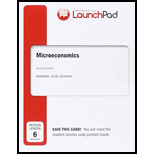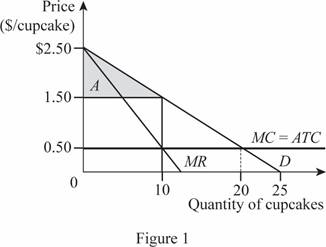
(a)
The profit maximizing quantity, profit made and the
(a)
Explanation of Solution
The
Thus, the profit maximizing quantity is 10. The output can be plugged into the demand function in order to calculate the profit maximizing price as given below:
Thus, the profit maximizing price is $1.50. The profit of the firm can be calculated as follows:
Thus, the total profit made by the firm is $10. This can be illustrated on the graph as follows:

The consumer surplus of the market is the area above the profit maximizing price and below the demand curve which is the area of A. It can be calculated as follows:
Thus, the consumer surplus of the market is $5.
(b)
The discount price of the cupcakes above 10 units.
(b)
Explanation of Solution
When the first 10 cupcakes are sold at $1.50 and after that the items are sold at discounted prices. Thus, the new inverse demand function is
Thus, the profit maximizing quantity is 5. The output can be plugged into the demand function in order to calculate the profit maximizing price as follows:
Thus, the profit maximizing price is $1.
(c)
The quantity ordered at full price and discounted price.
(c)
Explanation of Solution
The consumers will purchase a total of 10 units at the full price whereas at 5 units at discounted price of $1.
(d)
The new profit and the comparison with the normal profit.
(d)
Explanation of Solution
The profit from the normal plan to the seller is $10. After the discounting, the price becomes $1 and the output is 5. Thus, the profit can be calculated as follows:

Thus, the profit of the seller increases by $2.5 after the discounted pricing policy is introduced by the seller.
(e)
The three tire pricing system.
(e)
Explanation of Solution
The three tire pricing system can be introduced by splitting the total demand curve into four parts. Above the marginal revenue and below the marginal revenue. It can be done as $2.5 for the first 5 units, $1.5 for the next 5 units, $1 for units above 10 units. Thus, the total quantity sold is 15 units. Thus, the total profit of the firm can be calculated as follows:
Thus, the total profit earned is $15 which is higher than the two tire pricing in the economy.
(f)
The tire pricing system that declines from $2.40 to lower.
(f)
Explanation of Solution
The price for the first unit will be $2.40 and it declines by $0.10 for each additional units sold in the market. When the strategy goes on, the last unit price will be equal to the marginal cost of production which is $0.50. This implies that the total number units sold by the seller will be equal to 20 units and the pricing system followed by the seller will be a 20 tier pricing system. Thus, the total profit earned by the seller can be calculated as follows:
Thus, the total profit earned from the 20 tire pricing system is equal to $19.
(g)
The impact of 20 tire pricing on consumer surplus.
(g)
Explanation of Solution
When the 20 tire pricing policy is followed by the firm, it takes most of the consumers' willingness to pay which means the consumer surplus will be taken by the firm. Thus, it means that the complete consumer surplus of the economy would be captured by the firm as
Want to see more full solutions like this?
Chapter 10 Solutions
LaunchPad for Goolsbee's Microeconomics (Six Month Access)

 Principles of Economics (12th Edition)EconomicsISBN:9780134078779Author:Karl E. Case, Ray C. Fair, Sharon E. OsterPublisher:PEARSON
Principles of Economics (12th Edition)EconomicsISBN:9780134078779Author:Karl E. Case, Ray C. Fair, Sharon E. OsterPublisher:PEARSON Engineering Economy (17th Edition)EconomicsISBN:9780134870069Author:William G. Sullivan, Elin M. Wicks, C. Patrick KoellingPublisher:PEARSON
Engineering Economy (17th Edition)EconomicsISBN:9780134870069Author:William G. Sullivan, Elin M. Wicks, C. Patrick KoellingPublisher:PEARSON Principles of Economics (MindTap Course List)EconomicsISBN:9781305585126Author:N. Gregory MankiwPublisher:Cengage Learning
Principles of Economics (MindTap Course List)EconomicsISBN:9781305585126Author:N. Gregory MankiwPublisher:Cengage Learning Managerial Economics: A Problem Solving ApproachEconomicsISBN:9781337106665Author:Luke M. Froeb, Brian T. McCann, Michael R. Ward, Mike ShorPublisher:Cengage Learning
Managerial Economics: A Problem Solving ApproachEconomicsISBN:9781337106665Author:Luke M. Froeb, Brian T. McCann, Michael R. Ward, Mike ShorPublisher:Cengage Learning Managerial Economics & Business Strategy (Mcgraw-...EconomicsISBN:9781259290619Author:Michael Baye, Jeff PrincePublisher:McGraw-Hill Education
Managerial Economics & Business Strategy (Mcgraw-...EconomicsISBN:9781259290619Author:Michael Baye, Jeff PrincePublisher:McGraw-Hill Education





